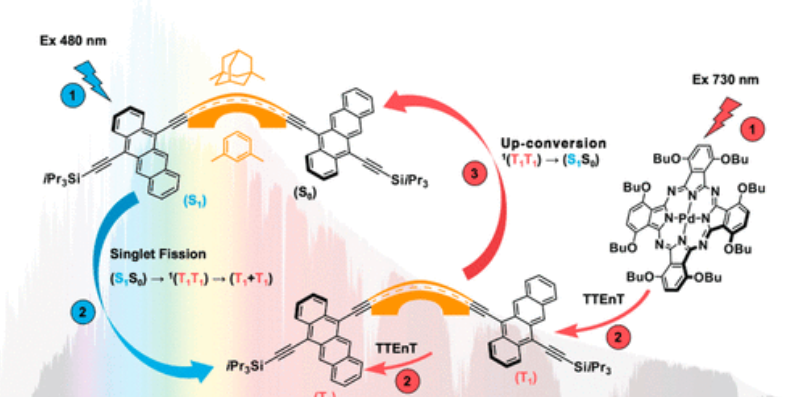Bo, Y., Hou, Y., Thiel, D., Weiß, R., Clark, T., Ferguson, M. J., Tykwinski, R. R., Guldi, D. M., Journal of the American Chemical Society 2023, 145, 18260-18275. 10.1021/jacs.3c02417
Photon energy conversion can be accomplished in many different ways, including the two opposing manners, down-conversion (i.e., singlet fission, SF) and up-conversion (i.e., triplet-triplet annihilation up-conversion, TTA-UC). Both processes have the potential to help overcome the detailed balance limit of single-junction solar cells. Tetracene, in which the energies of the lowest singlet excited state and twice the triplet excited state are comparable, exhibits both down- and up-conversion. Here, we have designed meta-diethynylphenylene- and 1,3-diethynyladamantyl-linked tetracene dimers, which feature different electronic coupling, to characterize the interplay between intramolecular SF (intra-SF) and intramolecular TTA-UC (intra-TTA-UC) via steady-state and time-resolved absorption and fluorescence spectroscopy. Furthermore, we have used Pd-phthalocyanine as a sensitizer to enable intra-TTA-UC in the two dimers via indirect photoexcitation in the near-infrared part of the solar spectrum. The work is rounded off by temperature-dependent measurements, which outline key aspects of how thermal effects impact intra-SF and intra-TTA-UC in different dimers.
The authors acknowledge the generous support of the STAEDTLER Foundation, which funded this work as part of the project Accelerated Innovation for a Sustainable Solar Energy Future.

Bo, Y., Hou, Y., Thiel, D., Weiß, R., Clark, T., Ferguson, M. J., Tykwinski, R. R., Guldi, D. M., Journal of the American Chemical Society 2023, 145, 18260-18275. 10.1021/jacs.3c02417
Photon energy conversion can be accomplished in many different ways, including the two opposing manners, down-conversion (i.e., singlet fission, SF) and up-conversion (i.e., triplet-triplet annihilation up-conversion, TTA-UC). Both processes have the potential to help overcome the detailed balance limit of single-junction solar cells. Tetracene, in which the energies of the lowest singlet excited state and twice the triplet excited state are comparable, exhibits both down- and up-conversion. Here, we have designed meta-diethynylphenylene- and 1,3-diethynyladamantyl-linked tetracene dimers, which feature different electronic coupling, to characterize the interplay between intramolecular SF (intra-SF) and intramolecular TTA-UC (intra-TTA-UC) via steady-state and time-resolved absorption and fluorescence spectroscopy. Furthermore, we have used Pd-phthalocyanine as a sensitizer to enable intra-TTA-UC in the two dimers via indirect photoexcitation in the near-infrared part of the solar spectrum. The work is rounded off by temperature-dependent measurements, which outline key aspects of how thermal effects impact intra-SF and intra-TTA-UC in different dimers.
The authors acknowledge the generous support of the STAEDTLER Foundation, which funded this work as part of the project Accelerated Innovation for a Sustainable Solar Energy Future.